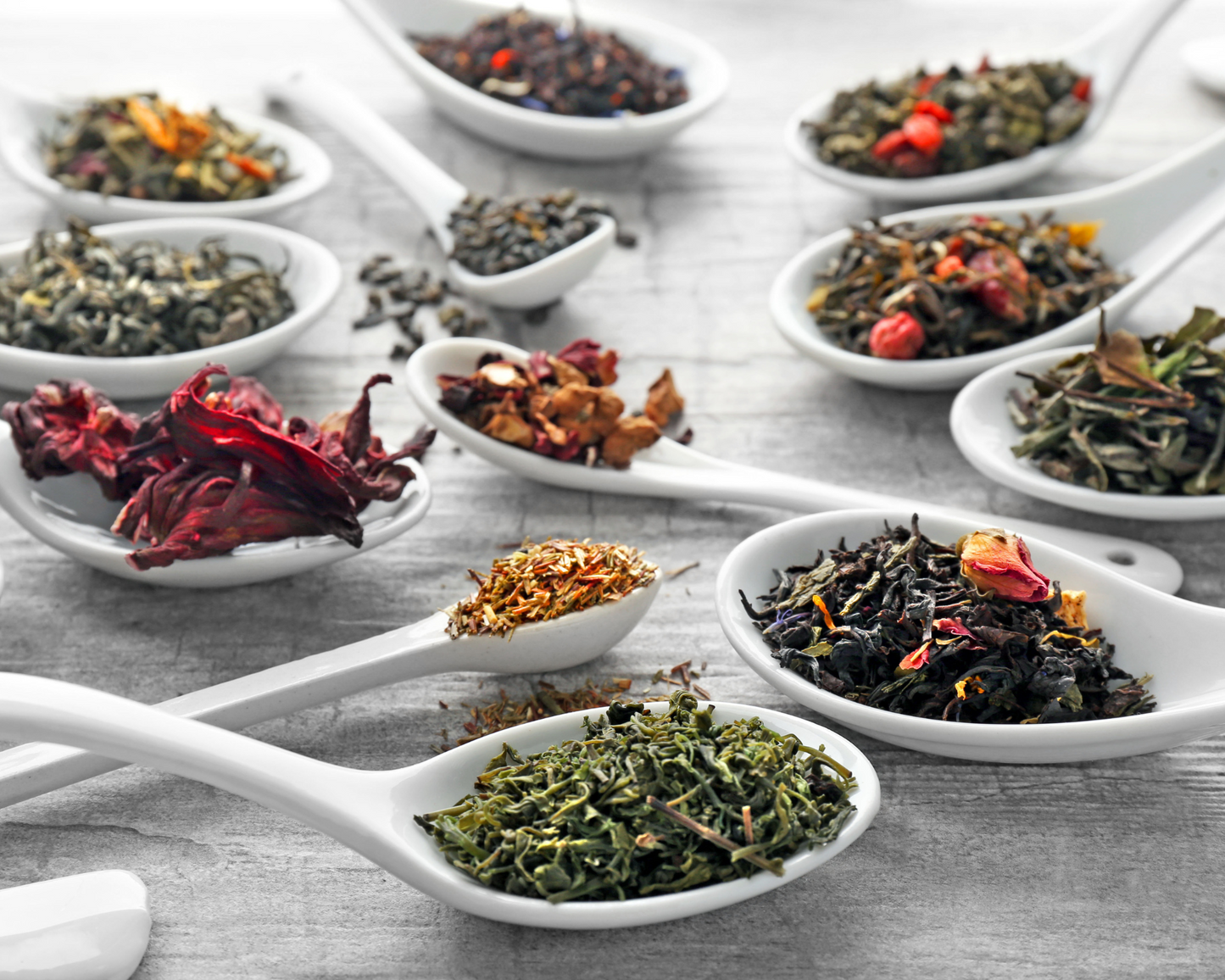
Want to flex your creative muscle and try something outside of your usual go-to tea rotation? Why not try making your own tea blend?
Blending tea is not only easy, but it gives you the opportunity to experiment with flavors and create a unique combination of those you enjoy the most. Read on to learn how to blend your own floral tea and explore a few of our suggested tea and floral pairings.
Some blending basics
The art of blending tea can be traced back more than 1,000 years, when tea leaves were layered with flowers, fruits and herbs to excite the senses of the Chinese imperial court.
Every tea blend uses one ingredient as a base. This is usually a pure tea (either white, green, black or oolong) or a dried herb/tisane (such as lemongrass). Your tea base will make up the bulk of your blend.
For making floral blends, you’ll want to experiment incorporating different flowers. Each flower – whether rose, jasmine or hibiscus, for example – will yield a different flavor.
Below we’ll share some of our favorite combinations you can make at home, but we encourage you to experiment with different tea base and flower blends to see what you like best. Your preferences may change with the seasons, the weather or even your mood, so, never stop trying new things!
Why blend your own tea?
There are plenty of reasons!
- With only a handful of different pure teas and herbs, flowers and spices, you can create numerous blends and enjoy a different tea each day.
- By changing only one or two ingredients, you can transform your tea from calming to energizing or from simple to complex.
- The addition of a few dried flower buds, for example, can also alter the flavor of tea, perhaps by adding a bit of natural sweetness. This is especially great for those who don’t necessarily love the flavor of a certain tea but want to drink it for its health benefits.
- Lastly, by blending your own tea, you can reduce the risk of drinking tea with sweeteners or artificial flavors sometimes hidden in blends.

DIY floral tea blend recipes
The amount of leaves used in the recipes below is enough for two to three infusions, depending on the recipe. Keep in mind that:
- Every flower is different, so it’s important to adjust the amounts to best suit your taste.
- The intensity of ingredients will depend on the type, quality and storing conditions of each ingredient. We suggest blending small amounts and trying them first.
- Once you have your tea base, all you’ll need is the flowers of your choice. You can find most of the ingredients for blending floral teas in health food stores – or on our website. You can even grow or collect your own.
Sencha Chrysanthemum Tea
Green tea and chrysanthemum are a classic pairing in the tea-drinking regions of Asia. Both are said to have cooling properties and promote fluid production, so this blend is particularly popular during the hot days of summer, as well as on dry autumn and spring days.
In Chinese medicine, both green tea and chrysanthemum are also believed to remove liver toxins and improve eye sight, calming excess “internal heat” brought on by eating too much heat-producing food (like stews and spicy meals).
This floral blend is especially refreshing when chilled, prepared using the cold-brew method. (Check out our easy, three-step cold brewing guide to learn how.)
Directions: Gently blend 2.5 tablespoons of sencha tea with 1.5 tablespoons of chrysanthemum flowers. Prepare using sencha brewing parameters.
Rosebud White Tea
Roses aren’t just pretty to look at; they’re also said to enhance our appearance by improving the skin complexion and moisture. In Chinese medicine, rosebud tea is consumed to regulate “qi” (or energy), improve blood circulation and provide relief from menstrual discomfort. Combined with the antioxidants of white tea, this blend is truly functional for your health.
Because rosebuds have a delicate aroma, they blend nicely with white tea. If you prefer a tea that’s more light and subtle, this blend is for you. Sip it slowly and literally stop to smell the roses.
Directions: Gently blend 2 tablespoons of a white tea with 3 to 4 dried rose buds. Prepare using white tea brewing parameters.
Lavender Lemongrass Tisane
Sleepy time tea enthusiasts will adore this blend of lemongrass herbal tea and lavender. Both ingredients are highly aromatic (and caffeine-free), so when married, they make the perfect cup to promote relaxation, relieve stress and prepare you for a good night’s rest.
Packed with vitamin C, lemongrass provides an added immunity boost, making it as functional as it is delightful.
Directions: Gently blend 1.5 tablespoons of lemongrass tea (you’ll love ours) with 1 teaspoon of lavender. Prepare using lemongrass tea brewing parameters.

Osmanthus Black Tea
Commonly enjoyed in east Asia, Osmanthus blossoms are versatile in cooking and in drinks, and offer countless health benefits, from promoting digestive and respiratory health to improving skin conditions and detoxing the body.
Osmanthus blossoms are incredibly aromatic (they were even once consumed by women to produce a natural fragrance in ancient China), so they generally pair well with most pure teas.
One of my favorite blends of all time is Taiwanese oolong and Osmanthus, but I’m also a fan of Osmanthus and black tea blends. In Chinese medicine, both black tea and Osmanthus boast a “warming” property, making this blend an ideal combination for colder weather.
Directions: Gently blend 1 tablespoons of black tea (try our Front Porch English Breakfast) with 1 teaspoon of Osmanthus flowers. Prepare using black tea brewing parameters.
Hojicha Rose Tea
Unlike traditional Japanese green teas, hojicha is roasted after the leaves are steamed. Along with removing all bitterness, the roasting process gives hojicha its signature earthy aroma, its reddish-brown color and a unique smoky taste. Since hojicha is low in caffeine, hojicha is the perfect alternative to coffee for those seeking a warm and toasty drink.
Rosebuds add a touch of sweetness and help to balance the earthiness of hojicha. The result is a unique one, and is perfectly relaxing in the evening.
Directions: Gently blend 1.5 tablespoons of hojicha tea with three rosebuds. Prepare using hojicha brewing parameters. (Learn how to brew Japanese green tea here.)
If you’re making a larger batch of your tea blend, we recommend that you store it in an air-tight, opaque container and keep it in a cool, dark area away spice, coffee and other items with strong aromas.
Have you tried making your own floral tea blends? Let us know about it by tagging us on Instagram @neworleansteacompany!
